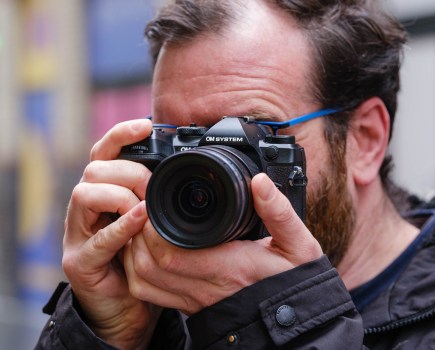Recently we ran a story on a big new social media campaign, #ToneProud, from major smartphone maker TECNO. It’s designed to raise awareness of a ‘skin-tone bias’ in imaging technology, which simply means that most phone cameras and generative AI technologies are currently not optimised to accurately capture all of the world’s diverse skin tones.
This is not a new problem. The bias was identified by technology-research leaders Stanford University and MIT back in 2018, and as you can imagine, it’s a source of constant frustration to smartphone users with diverse skin tones, who now number many millions worldwide.
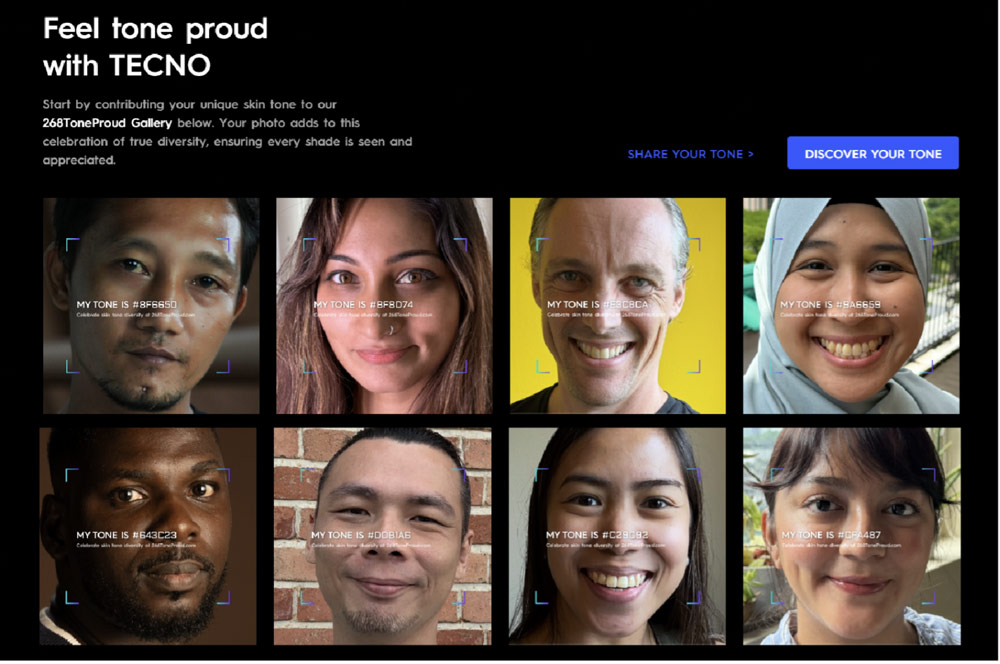
TECNO’s #ToneProud campaign launched this week
TECNO is particularly aware of this bias as it primarily operates in emerging markets, including Africa, South Asia, and the Middle East, so this fast-growing company is doing a lot to redress the balance in its smartphones.
On a practical level, this has a resulted in the development of TECNO Universal Tone, a sophisticated, AI-powered, multi-skin tone imaging technology that the company unveiled in 2023.
So, the technology uses a multi-skin tone colour card and the industry’s largest and most accurate skin tone database in order to deliver on a simple promise – to ensure that the skin tone of TECNO’s many diverse customers around the world is accurately reflected in the pictures and video they take with their phones.

TECNO’s mission is to ensure that the diverse skin tones of its many customers worldwide are accurately represented
Addressing skin-tone bias: TECNO’s three-pronged approach
Going into a bit more technical detail, Universal Tone technology is based on a multi-skin tone restoration engine, a local-tuning engine and a computational portrait engine. These work together to deliver accurate representations of diverse skin tones in images.
TECNO is also working with colour-science experts from some of the world’s top universities to continue the development and refinement of Universal Tone.
To find out more about Universal Tone and the #ToneProud campaign, we met up with Elva Zhou, Director of Image Quality Testing and Assessment Department (IQA), TECNO Image Quality Testing Lab.

Elva Zhou, Director of Image Quality Testing and Assessment Department (IQA), TECNO Image Quality Testing Lab
As Elva explains, TECNO developed Universal Tone for three main reasons. ‘Firstly, consumer demand. This stems from TECNO’s profound understanding of emerging market consumers, rather than merely following industry trends.
Regardless of which market TECNO visited, skin tone inaccuracy was the most common complaint we heard. In Africa, for example, smartphone portrait photography is prone to producing reddish, or overly darkened skin tones; in South and Southeast Asia, different lighting environments can lead to colour misrepresentation; in Eastern Europe, very fair skin tones are prone to overexposure.’
Second, TECNO spotted an opportunity to serve its very diverse customer base more effectively. As Elva notes, ‘as a brand with strong links to consumers in often-overlooked emerging markets, TECNO is well-equipped to serve users in these regions, and is the only smartphone brand that has developed diverse skin-colour imaging as one of its core strategies.’
Third, TECNO has focused on developing more accurate technology for skin tone representation for some time, giving it the edge over rivals.
‘Many mainstream smartphone brands use the most frequently seen skin tones of North American, Western European and East Asian users as a benchmark for skin colour recognition and representation in portrait photography,’ Elva points out. ‘TECNO, however, started its imaging technology development with more diverse skin tone photography as its foundation, and we have spent 10 years developing the necessary tools.’
An entire system for ensuring accurate multi-skin tone imaging
Elva is keen to stress that TECNO Universal Tone is not just an imaging technology, but an entire system that solves the problems encountered in multi-skin tone imaging. ‘This isn’t about adapting an existing technology, it’s about reimagining imaging technology with diversity at its core. To achieve this, TECNO has built the industry’s largest and most inclusive skin tone database, also taking advantage of AI algorithms.’

It’s really important that skin tones are accurately reflected in video, too
As well as focusing on underrepresented skin tones, particularly darker and less-common ones, Universal Tone is unique in offering a complete skin-colour evaluation system. This is built on skin-colour recognition detection, skin-colour classification, skin-colour grading, skin-colour calibration, and skin-colour enhancement algorithms. ‘The skin tone database is also being constantly updated,’ Elva adds, also citing a more scientific approach than seen in previous AI-based skin tone technologies.
Universal Tone is not the first technology to try and address skin-tone bias in imaging technology, but as Elva explains, there are key differences in TECNO’s approach. She elaborates:
‘TECNO has created an industry-first inclusive mobile imaging colour card featuring 268 skin tone patches to fine-tune the system’s algorithms. Universal Tone is specifically tuned for actual local scenarios in emerging markets, with dedicated research teams in different parts of the world sending back accurate data.
These include tests for skin tone representation under various colour temperatures, the effect of local lighting conditions and so on. TECNO typically covers over 200 different scenario groups for each country, fine-tuning the technology based on these regional tests. Whether it’s dark or light skin tones, individual portraits, or group shots with various skin tones, TECNO’s technology can significantly improve the multi-skin photography experience of users in emerging markets.’
Universal Tone – promoting positive self-recognition and pride
Currently, Universal Tone technology appears in the TECNO smartphone launched this year, namely the PHANTOM V Fold2 5G, PHANTOM V Flip2 5G and the CAMON 30 Series. ‘Going forward, TECNO intends to expand the technology to all of its product lines,’ Elva confirms.
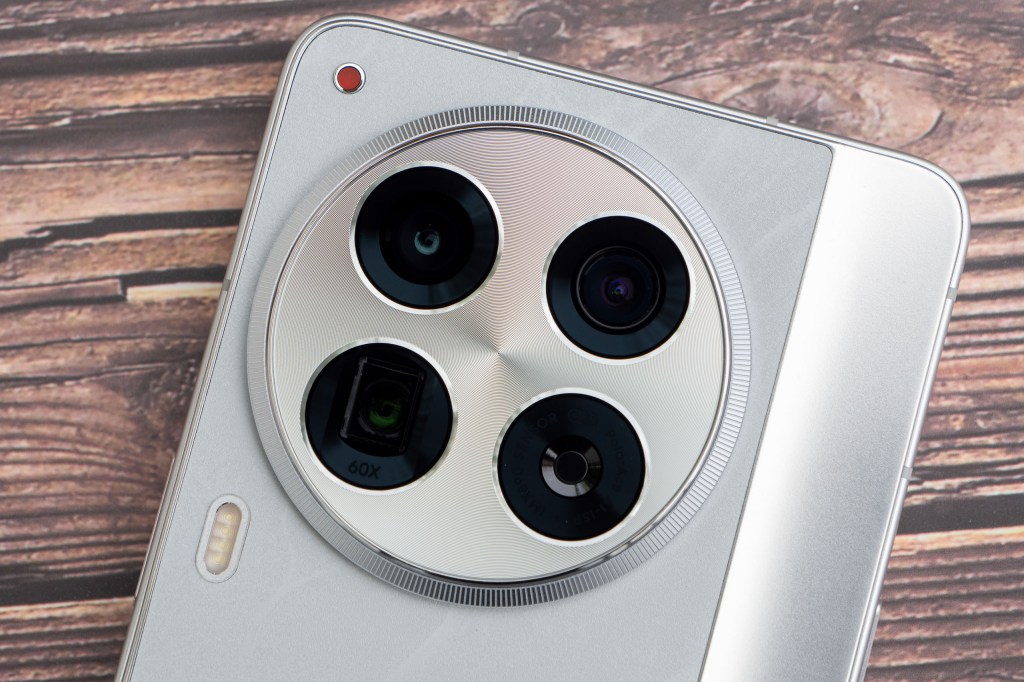
A close up of the camera modules for the Camon 30 Premier 5G. Image: Amy Davies
Innovative technology aside, it’s clear that TECNO regards this whole initiative as helping to achieve greater inclusivity, and a celebration of diversity. Elva is emphatic:
This isn’t just about capturing a good image, it’s about self-recognition and pride. It tells users, ‘you are seen, celebrated, and beautiful exactly as you are.’ By accurately representing diverse skin tones, TECNO is challenging long-held beauty standards and reshaping the visual landscape of our digital world.
When media, advertisements, and social platforms show a true spectrum of human diversity, it normalises and celebrates this diversity. Inclusivity in mobile imaging can play a crucial role in reducing prejudices and fostering a more inclusive society’.

TECNO’s Universal Tone technology is designed to celebrate the beauty of people exactly as they are
Beyond just algorithms: building a globally inclusive database
We mentioned AI before and Elva confirms that Universal Tone technology is based on the skilful application of artificial intelligence. ‘One of the core aspects of the Universal Tone technology is skin-colour evaluation and restoration – this capability is achieved by AI algorithms. However, without an unbiased and inclusive database and scientific measurement methods, the algorithm cannot perform in a way that truly captures diverse skin tones.’
As Elva explains, AI algorithms are not in themselves magic wands. ‘In the evaluation stage, AI needs to be trained and supported by inclusive and sufficient data. AI itself does not know what the real skin colour is, what the differences in skin-colour preferences of consumers in different regions and so on.’
Elva stresses the importance of taking into account very different local conditions when analysing this data – the lighting in Africa will markedly differ from that in Eastern Europe, for example – as well as regional cultural differences and aesthetic trends and fashions.

With every development, TECNO is getting closer to its goal of ensuring phones capture accurate skin tone as seen by the human eye
Fixing skin-tone bias is a big task, but Elva remains confident that over the next decade, the development of skin-colour processing technology in mobile imaging will become more and more realistic and accurate. ‘These advancements will bring us closer to a truly realistic representation of skin colour as seen by the human eye.
Going forward, TECNO is focusing on improving the diversity and accuracy of skin colour restoration in generative AI, expanding the skin tone database beyond the current 268 skin tone patches, and bringing Universal Tone to more TECNO devices.’
Be #ToneProud
Returning to the present, we asked Elva to talk more about the current #ToneProud social media campaign. ‘As an expert in multi-skin tone imaging, TECNO hopes to highlight the need for in-depth, unbiased, local research and development in order to develop more appropriate and inclusive technologies,’ she explains.
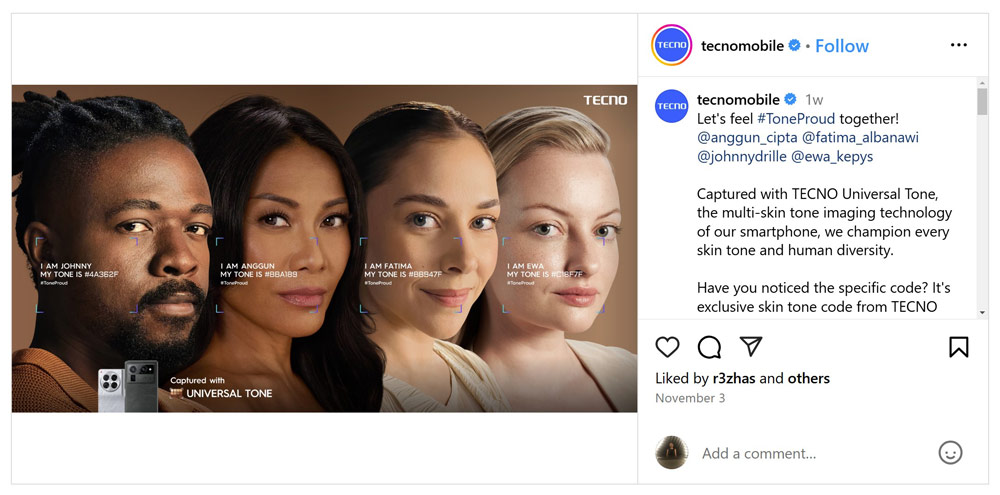
The #ToneProud campaign has got off to a great start on Instagram and other major social media platforms
‘We are highlighting 268 skin tone patches, which stem from TECNO’s multi-skin tone colour card – as discussed, this forms the basis of the Universal Tone technology. By focusing on the number 268, we want to convey to consumers that skin colour is not defined by race nor simplistically divided into black and white. Skin tone is diverse and varied, and everyone should feel proud and confident in their own skin tone.’

These celebrities know their skin-tone type – do you?
The #ToneProud campaign is supported by a diverse group of international celebrities (above), including Indonesia-born singer-songwriter Anggun, Saudi Arabian filmmaker and actress Fatima Al-Banawi, Nigerian singer-songwriter Johnny Drille, and Polish actress Ewa Kępys.
A thought-provoking movie has been posted on YouTube, which you can watch below.
As Elva explains, social media is a great way to get many more people engaged. ‘We want people to make their voices heard by engaging with the campaign at 268toneproud.com – a website that allows everyone to discover their own skin tone code, according to TECNO’s 268 skin tone patches. People can join the conversation by sharing their portrait and skin tone code on social media in a united message with people around the world that we should all be proud of our own skin tones.’
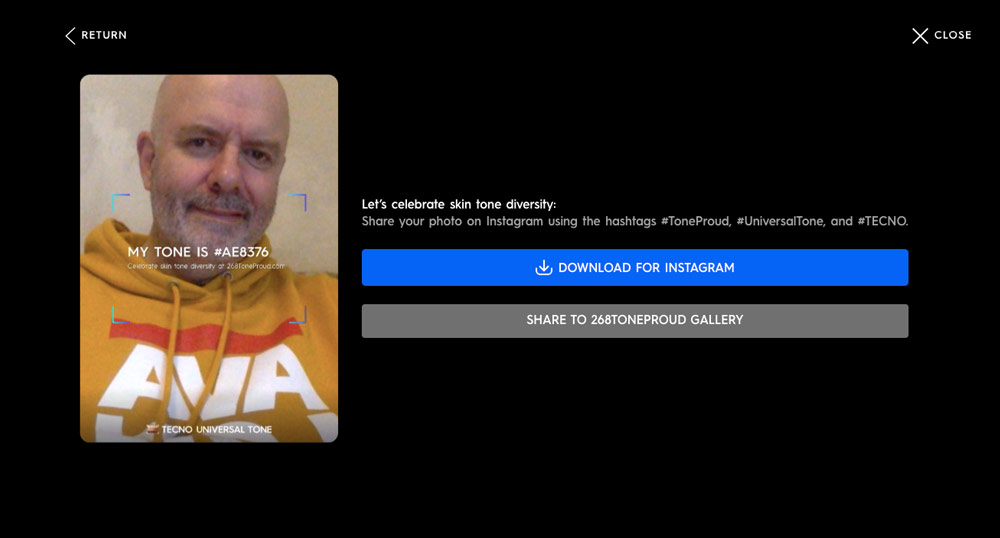
What’s your skin tone? Find out and share with TECNO’s #ToneProud campaign
To find out more about TECNO phones see here. You can find out your own skin tone at the new website launched for the #ToneProud campaign, then share on the 268TONEPROUD gallery or on Instagram.





